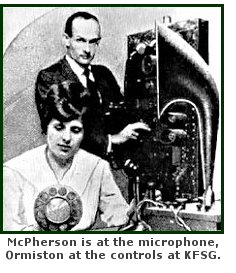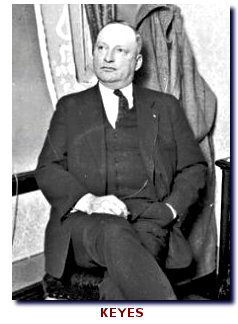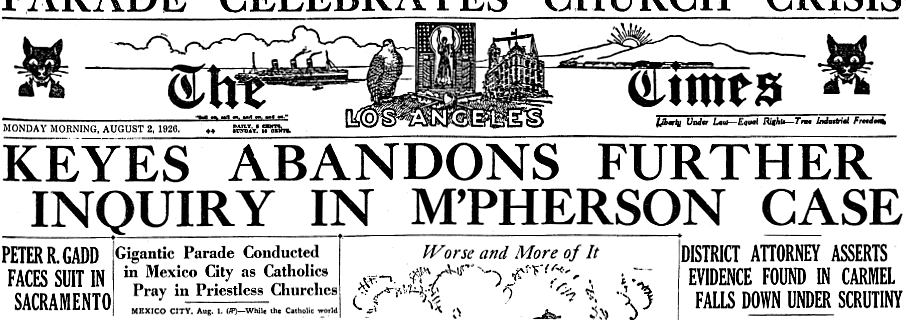Monday, August 13, 2007
Page 15
REMINISCING (Column)
District Attorney Keyes Remembered for Role in Aimee Semple McPherson Case
By ROGER M. GRACE
Forty-Fourth in a Series
ASA KEYES, district attorney of Los Angeles County from 1923-28, has been portrayed in movies and on the stage. He’s been depicted in connection with prosecutorial efforts that came after celebrity-minister Aimee Semple McPherson apparently faked having been kidnapped.
Keyes has been played by James Sloyan in the 1976 “Hallmark Hall of Fame” TV movie, “The Disappearance of Aimee”; by Charles Gorgano in the 2006 flick, “Aimee Semple McPherson”; and by Matt Loney in 2005 (in New York) and Andrew Long earlier this year (in Virginia) in “Saving Aimee,” an on-stage musical by Kathie Lee Gifford.
The musical begins with Keyes reading the charges against McPherson: “corruption of morals, obstruction of justice, and conspiracy to manufacture evidence.”
It’s ironic that Keyes would be remembered not so much in connection with his own trial, conviction, and imprisonment for accepting a bribe as for his earlier role in the McPherson matter. This entailed gaining an order in the Municipal Court binding McPherson over for trial in the Superior Court—a trial that never took place.
Keyes was less than a determined “champion of justice.” His prosecutorial efforts were put forth with reluctance, under public pressure
![]()
McPherson
was a mesmerizing radio
evangelist with a massive following. She built, through donations, the $1.5
million Angelus Temple—with a seating capacity of 5,300—on Glendale Boulevard, just
north of Echo Park and south of Sunset Boulevard. It was opened on New Year’s
Day in 1923, and still stands—though its twin broadcasting towers are no longer
there. McPherson had operated  her own radio station, KFSG, on the grounds. It
went on the air Feb. 6, 1924. “FSG” stood for Foursquare Gospel, named after
the Christian denomination she founded, the International Church of the
Foursquare Gospel, which still exists.
her own radio station, KFSG, on the grounds. It
went on the air Feb. 6, 1924. “FSG” stood for Foursquare Gospel, named after
the Christian denomination she founded, the International Church of the
Foursquare Gospel, which still exists.
The disappearance of McPherson took place on May 18, 1926. She went into the waters near her home at Ocean Park; she was not seen coming out. It was widely feared she had drowned, and mourners swarmed the beach to bring flowers and pray.
By odd coincidence, an engineer for KFSG, Kenneth G. Ormiston, disappeared right about the same time.
On June 19, McPherson’s mother and business manager, Minnie Kennedy, purportedly received by mail a $500,000 ransom demand, and $40,000 was raised in short order from contributions to the church.
Then, on June 23, “Sister Aimee” reappeared…with a fantastic tale. As Edith Blumhofer relates it in her 1993 book, “Aimee Semple McPherson: Everybody’s Sister”:
“Sister insisted she had been abducted by two men and a woman who lured her from the beach to their car with a request that she pray for a child. Bound, gagged, and numbed by ether, she had been held in California, then moved to a shack in northern Mexico. After escaping, she had wandered the desert for hours, finally stumbling weak and distraught into the porch of a mystified resident of Agua Prieta who had helped her cross the Mexican border into Douglas, Arizona. Los Angeles’s feisty district attorney, Asa Keyes (who, a few months earlier, basking in Sister’s warm welcome, had addressed a standing-room-only crowd at Angelus Temple on the church and civic responsibility), countered with another version that placed her in a Carmel bungalow with Angelus Temple’s radio engineer Kenneth G. Ormiston.”
Former California state Librarian Kevin Starr, in his 1996 book “Material Dreams: Southern California through the 1920’s,” says:
“Researchers with a taste for American-style grande guignol have patiently unraveled the entire episode. It is all but certain that Sister Aimee took a month’s vacation in the company of Kenneth Ormiston, spending part of this time in a honeymoon cottage in Carmel. District Attorney Asa Keyes produced a grocery list from the Carmel cottage in what was unmistakably McPherson’s handwriting.”
![]()
Efforts by Keyes to determine whether there had, in fact, been a kidnapping were on-again, off-again.
They were on starting June 23, the day McPherson reemerged. Keyes issued this statement:
Every effort will be made by this office to solve the mystery of the disappearance of Aimee Semple McPherson. If a person as well known as Mrs. McPherson can be kidnaped from a public beach in broad daylight, carried out of the county by force and violence and held prisoner for an extended period of time, extreme measures must be used to make certain that such an outrage can not recur.
No matter what the circumstances of Mrs. McPherson’s disappearance, every phase of the case will be fairly and thoroughly investigated and every movement of Mrs. McPherson retraced until the mystery is completely and finally explained.
I am sending a deputy immediately to Douglas, in company with a representative of the police department, to begin the investigation coincidentally both in that city and in Los Angeles. If Mrs. McPherson was kidnaped and held prisoner, no law enforcement agency in this county will rest until the kidnapers are apprehended and brought to justice.
Efforts were off as of June 28. Here’s how the Oxnard Daily Courier’s report on the development that day begins:
“Investigation
of Aimee Semple McPherson’s statement of having been kidnapped and held for ransom and search for her abductors was dropped today by the district attorney’s office. The police search and investigation, however, will continue.
was dropped today by the district attorney’s office. The police search and investigation, however, will continue.
“District Attorney Keyes admitted that his office would make no further investigation of Mrs. McPherson’s story. Asked the reason for dropping the investigation, Keyes stated curtly:
“ ‘I have nothing to say.’ ”
Deputy District Attorney Joseph Ryan, who was in charge of the DA’s investigation, subsequently told the press he was ready to go before the Grand Jury. Keyes slapped him down. This is from an Associated Press report of July 1:
“Newspapermen who were present at a conference to-day between Keyes and Ryan reported that Keyes censured his subordinate for having made the statement.”
The AP dispatch went on to say:
“It was learned to-day that at least three members of the grand jury are prepared to demand that the district attorney’s office lay all of the details of the McPherson case before them.”
![]()
In a turnabout, Keyes appeared before the Grand Jury on July 6 urging an investigation, and there was a unanimous vote to launch one. Subpoenas were issued for McPherson and others to appear.
On that same date, in what amounted to a blatant publicity stunt, Keyes personally handed McPherson her subpoena.
In the 1986 book, “Women of the 20s,” George H. Douglas writes:
“So on the morning of July 8, 1926, Aimee, attended by a phalanx of Temple escorts and attired in a simple white crepe dress and a long blue cape, made her way downtown to the massive Hall of Justice, in answer to a summons from the grand jury. At this hearing, District Attorney Keyes not only probed every inconsistency in Aimee’s story—and there were many—but also raised questions concerning Kenneth Ormiston, for at least one witness had reported seeing McPherson and Ormiston in a car together a day before Aimee reappeared in Douglas, Arizona. Through it all, Aimee cheerfully maintained her story of kidnapping, and later that afternoon she made her own summation to the seventeen men and two women of the jury, defending her ministry and explaining its humble origins in moving detail.”
A report by United News of McPherson’s testimony says:
“Unruffled after six hours of giving testimony and submitting to severe questioning, Aimee Semple McPherson walked out of the grand jury room this evening, apparently the victor in the first round of the probe into her kidnaping story.”
After 12 days of testimony from various witnesses, the Grand Jury concluded it did not have enough evidence to reach any conclusions.
![]()
But evidence continued to be gathered. On July 26, according to news reports, two employees of a real estate office in Carmel identified Ormiston, from a photograph, as the man to whom they had rented a cottage on May 22…and a townsman, shown a photo of McPherson, signed statement on the back of it saying:
“This is the woman I saw in the garage of the Benedict cottage at Carmel, May 24, 1926, when I delivered wood.”
He recalled that she had been there in the company of the man who had placed the order.
The evidence was being gathered in Carmel by Ryan, who told reporters that he had at least nine witnesses who placed Ormiston in that seaside community during the relevant time period.
A set of fingerprints was taken from a spice can left behind when the couple departed on May 29. The grocery list alluded to in Starr’s book was also uncovered at that time.
It looked like the investigation was about to bear fruit. In fact, on July 27, Los Angeles Police Department Chief of Detectives Herman H. Cline proclaimed that the case had been solved and evidence was “conclusive” that the kidnapping was a ruse. Keyes called for a reopening of the Grand Jury’s inquiry.
![]()
But then came a set-back for the prosecution.
An AP story transmitted from Los Angeles on July 30 says: “Fingerprint experts of the police department announced today that finger marks obtained in a cottage at Carmel so far examined could not be identified as those of Aimee Semple McPherson, owing to their blurred condition.”
The Oakland Tribune’s issue of Sunday morning, Aug. 1, contains this report from Monterey, dated July 31:
“Thirteen subpenas from the Los Angeles grand jury were served late today upon persons who had identified Mrs. Aimee McPherson and Kenneth Ormiston, her radio operator, as occupants of the ‘McIntire cottage’ during the days when Mrs. McPherson, Los Angeles evangelist, was supposedly the captive of kidnapers.
“Within an hour after the subpenas had been served by C. H. Conn, Los Angeles process server, he notified the witnesses that the subpenas had been voided by a telegram from Los Angeles notifying him that the grand jury session, set for Tuesday, had been called off.”
The telegram read, according to the report: “Don’t serve subponeas [sic]; come home.”
(Reference to the “McIntire Cottage” stemmed from the occupants having registered as “Mr. and Mrs. George McIntyre,” sometimes using the spelling, “McIntire.”)
Reporters located Keyes on Aug. 1 on a golf course. As the Times’ report the next morning recounts, he announced that he was going to drop any efforts to either ferret out kidnappers or prosecute anyone for having committed perjury before the Grand Jury. He pointed to the lack of fingerprint evidence and the extreme difficulty of proving a case of perjury.
That development was the top story of the day, as reflected by the Times’ treatment of it:

An Associated Press dispatch on Aug. 2 reports that Ormiston had testified in a deposition, just made public, that he had been in Carmel with a “Miss X,” who was not McPherson.
On Aug. 3, Keyes laid before the grand jury the evidence accumulated to date, and it agreed with him that there was basis for an indictment.
In a statement issued Aug. 5, Keyes said the fingerprints were “utterly beyond identification” and that further investigation shows “that the witnesses are not positive.”
He declared:
“Personally, I am unwilling to assume the responsibility of incurring the enormous expense of a criminal trial unless and until the grand jury is prepared to justify it. Hasty or ill-considered action in this case would plunge this county into a religious turmoil. A mistrial would be expensive and unjust both to the people and the accused.”
The shopping list in McPherson’s handwriting, found in the trash at the cottage, was momentarily eluding the DA. I’ll pick up at this spot in the next column.
Copyright 2007, Metropolitan News Company